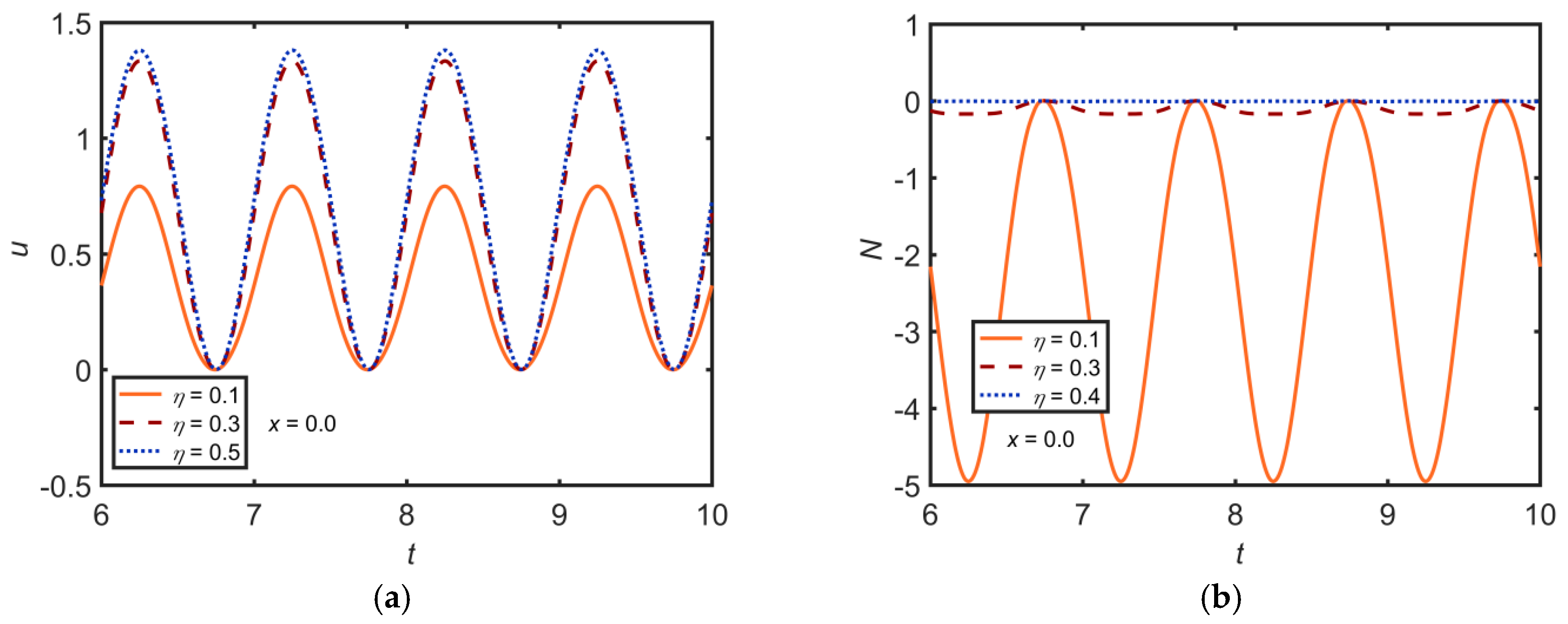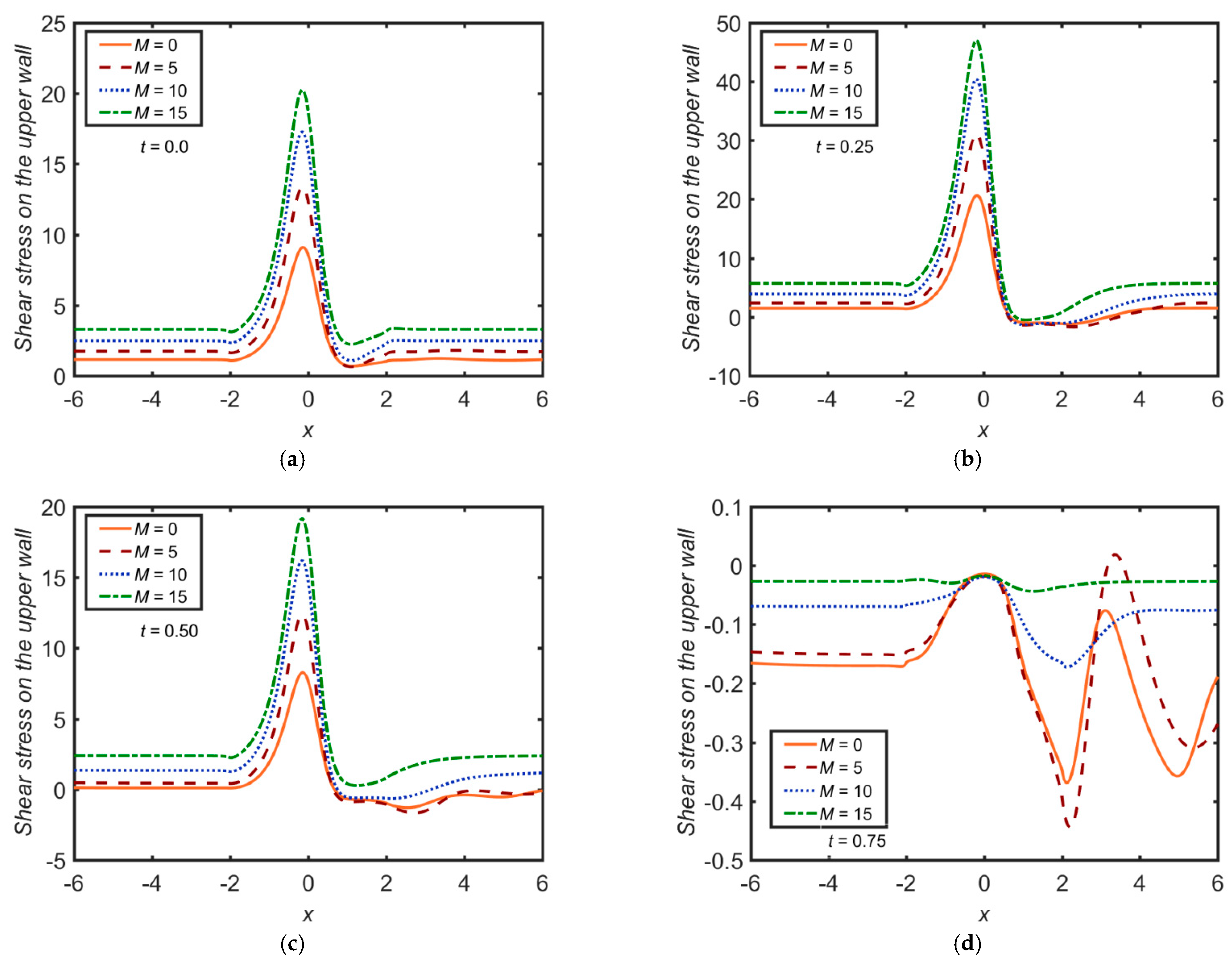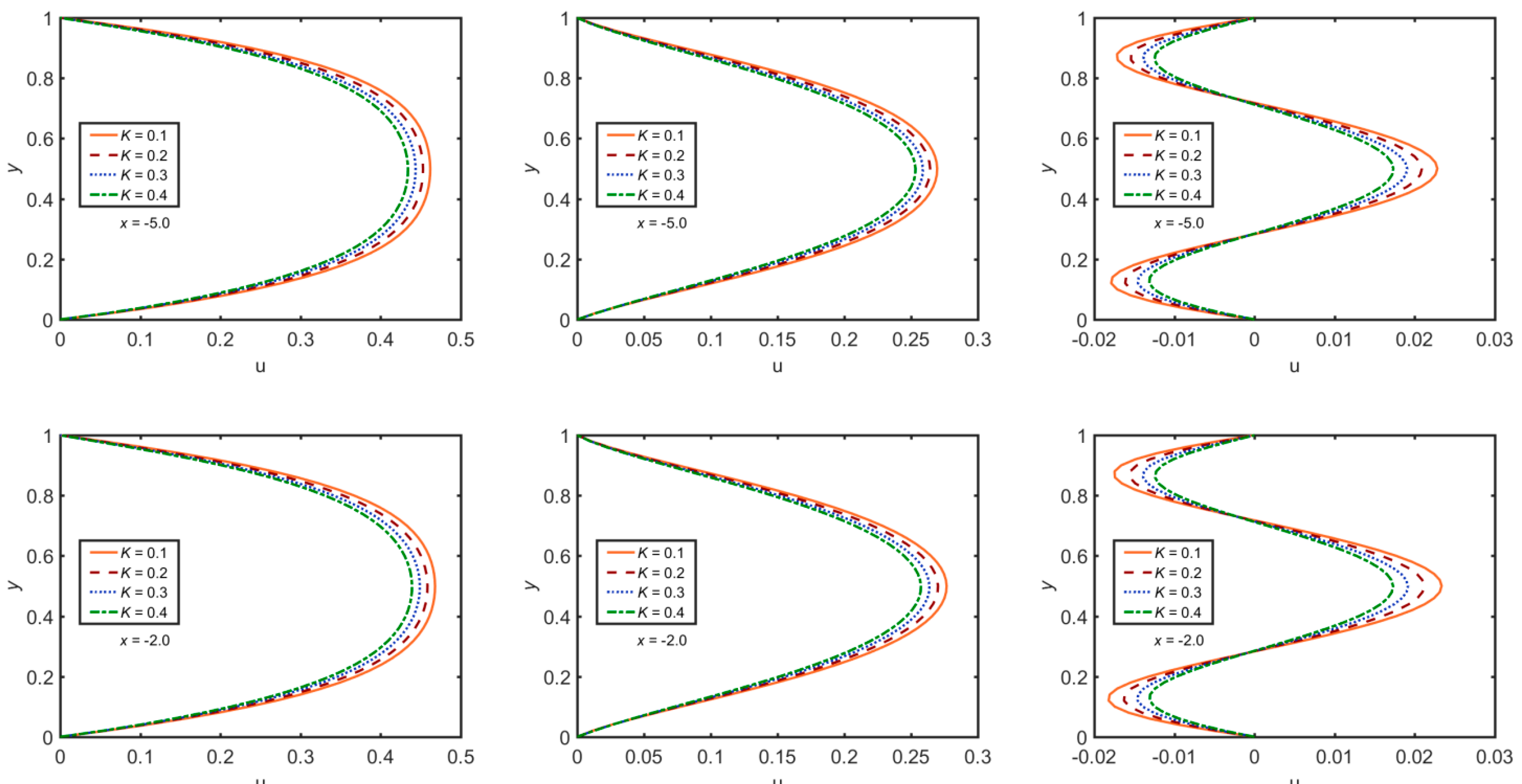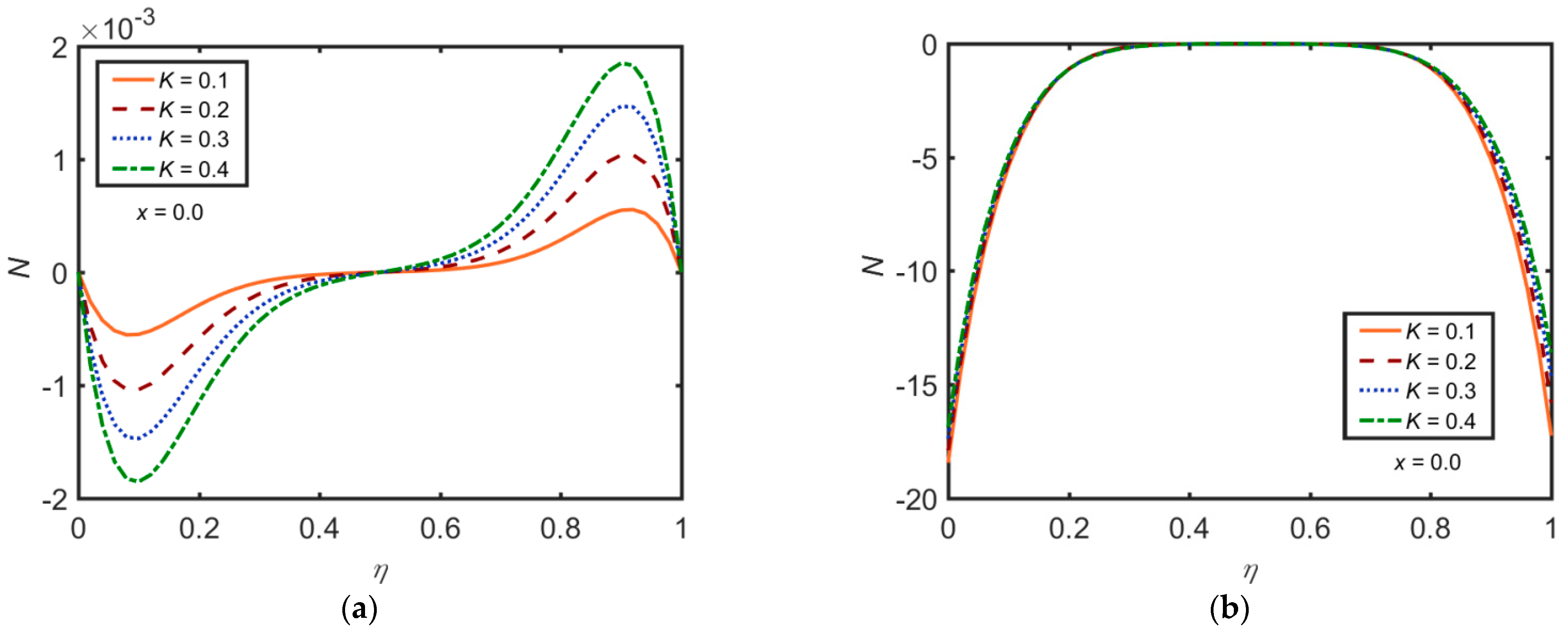Impact of Lorentz Force in Thermally Developed Pulsatile Micropolar Fluid Flow in a Constricted Channel
Abstract
:1. Introduction
2. Mathematical Formulation
2.1. Governing Equations
2.2. Vorticity-Stream Function Formulation
2.3. Boundary Conditions
2.4. Transformation of Coordinates
3. Results and Discussion
4. Conclusions
- The thermal boundary layer is observed to have an inverse relationship with the Hartman number and Prandtl number during the whole of the pulsation cycle.
- The WSS has an inciting trend towards At , the WSS attains its peak value for a given value of . Similar behaviour is seen on varying and . The WSS has a declining trend towards . However, there is no effect of and on the WSS.
- The profile has an inciting trend towards and but it has a declining trend towards . There is no effect of and on the profile.
- The profile has an inciting trend towards and , whereas a declining trend towards is observed. No significant impact of other parameters on the profile is observed.
- The profile has a declining trend towards , , and . In contrast, it has an inciting trend towards and . Since a declining trend in the profile towards is observed, it can be deduced that a thinner thermal boundary layer is caused due to a larger value of .
- The dimensionless parameter has an inciting trend towards and whereas it has a declining trend towards .
Author Contributions
Funding
Institutional Review Board Statement
Informed Consent Statement
Conflicts of Interest
References
- Eringen, A.C. Simple microfluids. Int. J. Eng. Sci. 1964, 2, 205–217. [Google Scholar] [CrossRef]
- Maiti, G. Convective Heat Transfer in Micropolar Fluid Flow Through a Horizontal Parallel Plate Channel. ZAMM-J. Appl. Math. Mech. Z. Angew. Math. Mech. 1975, 55, 105–111. [Google Scholar] [CrossRef]
- Ojjela, O.; Naresh Kumar, N. Unsteady MHD flow and heat transfer of micropolar fluid in a porous medium between parallel plates. Can. J. Phys. 2015, 93, 880–887. [Google Scholar] [CrossRef]
- Perdikis, C.; Raptis, A. Heat transfer of a micropolar fluid by the presence of radiation. Heat Mass Transf. Stoffuebertragung 1996, 31, 381–382. [Google Scholar] [CrossRef]
- Gorla, R.S.R.; Pender, R.; Eppich, J. Heat transfer in micropolar boundary layer flow over a flat plate. Int. J. Eng. Sci. 1983, 21, 791–798. [Google Scholar] [CrossRef]
- Makinde, O.D.; Kumar, K.G.; Manjunatha, S.; Gireesha, B.J. Effect of nonlinear thermal radiation on MHD boundary layer flow and melting heat transfer of micro-polar fluid over a stretching surface with fluid particles suspension. Defect Diffus. Forum 2017, 378, 125–136. [Google Scholar] [CrossRef]
- Turkyilmazoglu, M. Flow of a micropolar fluid due to a porous stretching sheet and heat transfer. Int. J. Non-Linear Mech. 2016, 83, 59–64. [Google Scholar] [CrossRef]
- Ashraf, M.; Wehgal, A.R. MHD flow and heat transfer of micropolar fluid between two porous disks. Appl. Math. Mech. 2012, 33, 51–64. [Google Scholar] [CrossRef]
- Rashidi, M.M.; Mohimanian Pour, S.A.; Abbasbandy, S. Analytic approximate solutions for heat transfer of a micropolar fluid through a porous medium with radiation. Commun. Nonlinear Sci. Numer. Simul. 2011, 16, 1874–1889. [Google Scholar] [CrossRef]
- Lu, D.; Kahshan, M.; Siddiqui, A.M. Hydrodynamical study of micropolar fluid in a porous-walled channel: Application to flat plate dialyzer. Symmetry 2019, 11, 541. [Google Scholar] [CrossRef] [Green Version]
- Javadi, H. Investigation of micropolar fluid flow and heat transfer in a two-dimensional permeable channel by analytical and numerical methods. Sigma J. Eng. Nat. Sci. 2019, 37, 393–413. [Google Scholar]
- Doh, D.H.; Muthtamilselvan, M.; Prakash, D. Effect of heat generation on transient flow of micropolar fluid in a porous vertical channel. Thermophys. Aeromechanics 2017, 24, 275–284. [Google Scholar] [CrossRef]
- Miroshnichenko, I.V.; Sheremet, M.A.; Pop, I.; Ishak, A. Convective heat transfer of micropolar fluid in a horizontal wavy channel under the local heating. Int. J. Mech. Sci. 2017, 128–129, 541–549. [Google Scholar] [CrossRef]
- Mekheimer, K.S. Peristaltic flow of a magneto-micropolar fluid: Effect of induced magnetic field. J. Appl. Math. 2008, 2008. [Google Scholar] [CrossRef]
- Young, D.F. Fluid mechanics of arterial stenoses. J. Biomech. Eng. 1979, 101, 157–175. [Google Scholar] [CrossRef]
- Shit, G.C.; Roy, M. Pulsatile flow and heat transfer of a magneto-micropolar fluid through a stenosed artery under the influence of body acceleration. J. Mech. Med. Biol. 2011, 11, 643–661. [Google Scholar] [CrossRef]
- Ellahi, R.; Rahman, S.U.; Nadeem, S.; Akbar, N.S. Influence of heat and mass transfer on micropolar fluid of blood flow through a tapered stenosed arteries with permeable walls. J. Comput. Theor. Nanosci. 2014, 11, 1156–1163. [Google Scholar] [CrossRef]
- Haghighi, A.R.; Asl, M.S. Mathematical modeling of micropolar fluid flow through an overlapping arterial stenosis. Int. J. Biomath. 2015, 8, 1550056. [Google Scholar] [CrossRef]
- Ali, A.; Farooq, H.; Abbas, Z.; Bukhari, Z.; Fatima, A. Impact of Lorentz force on the pulsatile flow of a non-Newtonian Casson fluid in a constricted channel using Darcy’s law: A numerical study. Sci. Rep. 2020, 10, 1–15. [Google Scholar] [CrossRef]
- Bukhari, Z.; Ali, A.; Abbas, Z.; Farooq, H. The pulsatile flow of thermally developed non-Newtonian Casson fluid in a channel with constricted walls. AIP Adv. 2020, 11, 025324. [Google Scholar] [CrossRef]
- Ali, A.; Umar, M.; Bukhari, Z.; Abbas, Z. Pulsating flow of a micropolar-Casson fluid through a constricted channel influenced by a magnetic field and Darcian porous medium: A numerical study. Results Phys. 2020, 19, 103544. [Google Scholar] [CrossRef]
- Wu, J.Z.; Ma, H.Y.; Zhou, M.D. Vorticity and Vortex Dynamics; Springer Science and Business Media: Berlin, Germany, 2007. [Google Scholar]
- Ali, A.; Syed, K.S. An Outlook of High Performance Computing Infrastructures for Scientific Computing; Elsevier Inc.: Amsterdam, The Netherlands, 2013; Volume 91. [Google Scholar] [CrossRef]
- Bandyopadhyay, S.; Layek, G.C. Study of magnetohydrodynamic pulsatile flow in a constricted channel. Commun. Nonlinear Sci. Numer. Simul. 2012, 17, 2434–2446. [Google Scholar] [CrossRef]



















Publisher’s Note: MDPI stays neutral with regard to jurisdictional claims in published maps and institutional affiliations. |
© 2021 by the authors. Licensee MDPI, Basel, Switzerland. This article is an open access article distributed under the terms and conditions of the Creative Commons Attribution (CC BY) license (https://creativecommons.org/licenses/by/4.0/).
Share and Cite
Umar, M.; Ali, A.; Bukhari, Z.; Shahzadi, G.; Saleem, A. Impact of Lorentz Force in Thermally Developed Pulsatile Micropolar Fluid Flow in a Constricted Channel. Energies 2021, 14, 2173. https://doi.org/10.3390/en14082173
Umar M, Ali A, Bukhari Z, Shahzadi G, Saleem A. Impact of Lorentz Force in Thermally Developed Pulsatile Micropolar Fluid Flow in a Constricted Channel. Energies. 2021; 14(8):2173. https://doi.org/10.3390/en14082173
Chicago/Turabian StyleUmar, Muhammad, Amjad Ali, Zainab Bukhari, Gullnaz Shahzadi, and Arshad Saleem. 2021. "Impact of Lorentz Force in Thermally Developed Pulsatile Micropolar Fluid Flow in a Constricted Channel" Energies 14, no. 8: 2173. https://doi.org/10.3390/en14082173
APA StyleUmar, M., Ali, A., Bukhari, Z., Shahzadi, G., & Saleem, A. (2021). Impact of Lorentz Force in Thermally Developed Pulsatile Micropolar Fluid Flow in a Constricted Channel. Energies, 14(8), 2173. https://doi.org/10.3390/en14082173







